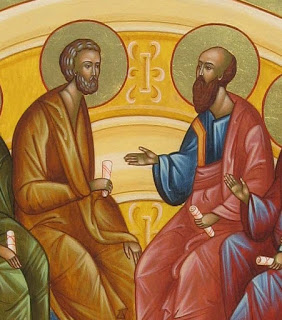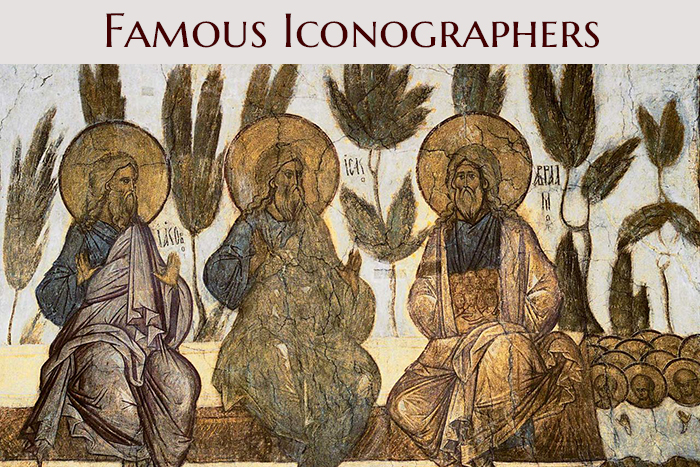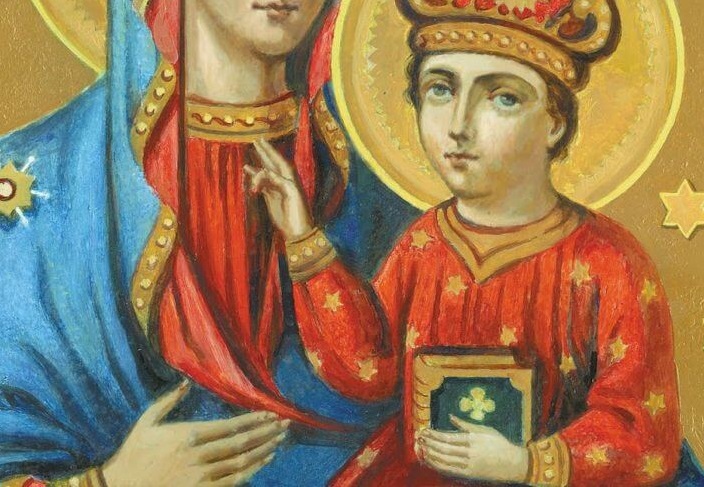
The Icon for the feast of Pentecost is also called the Descent of the Holy Spirit, as it is a depiction of the event described in the Book of Acts (Acts 2:1-4) when the Holy Spirit descended as tongues of fire upon the Apostles gathered together and enabled them to preach in different languages. However, the Feast of Pentecost is not only the commemoration of an historical event, but a celebration of a present reality: the presence of the Holy Spirit in the Church. Likewise, the Icon for Pentecost is much more than the depiction of a past event.
 The presence of the Apostle Paul in the icon, even though at that time he had not yet converted on the road to Damascus, hints that this icon is more than a purely historical picture. Sometimes, the evangelists Luke and Mark are also shown, despite also not having been present in the upper chamber at Pentecost. The gathering, then, is a representation of the Church. The Apostles are seated in a semi-circle, representing a unity and harmony similar to that found in Icons of the Holy Trinity. As in icons of the Holy Trinity, a semi-circle, rather than a full circle, is used so that we as observers are drawn into the unity.
The presence of the Apostle Paul in the icon, even though at that time he had not yet converted on the road to Damascus, hints that this icon is more than a purely historical picture. Sometimes, the evangelists Luke and Mark are also shown, despite also not having been present in the upper chamber at Pentecost. The gathering, then, is a representation of the Church. The Apostles are seated in a semi-circle, representing a unity and harmony similar to that found in Icons of the Holy Trinity. As in icons of the Holy Trinity, a semi-circle, rather than a full circle, is used so that we as observers are drawn into the unity.The source of their unity is in another semi-circle at the top of the icon, showing the descent of the Holy Spirit. From the blue semi-circle (c.a. mandorlas) a single ray of light for each of those gathered shines down to illumine them. Sometimes the “tongues of fire” described in Acts are shown at the tips of the rays, ready to descend upon the Apostles. Other times, the tongues of fire are shown already within the halos of each of the seated Saints. Some icons of Pentecost show a dove, either within the mandorla at the top of the icon, or even descending upon those gathered in the upper chamber. Given the appearance of the Holy Spirit as a dove during Christ’s Baptism, it is understandable that this physical image of the Spirit is also used in Pentecost icons. However, the Holy Spirit appeared as tongues of flame at Pentecost, and a dove at Christ’s Baptism, being – in reality – neither of these things. Therefore it is inappropriate to depict the Holy Spirit as a dove at Pentecost, or indeed in any icon except those for the Theophany feast.

At the bottom of the Icon is another semi-circle, showing an old king against a dark background. He is often named as Kosmos and represents the world. He is crowned as a symbol of earthly authority – i.e. he represents all the peoples of the world, rather than the whole of creation. He is sat “in darkness and the shadow of death” (Luke 1:79), and is aged to show the corruptibility of the world. Yet he also holds a blanket containing scrolls representing Apostolic teaching (compare with the scrolls held by the Apostles in the Icon itself and “the meaning of objects held by saints in icons“). Though in darkness, the descent of the Holy Spirit has not only reached the Apostles, but also all corners of the world into which the Apostles will preach the Gospel. The Empty Seat A striking aspect of the Pentecost Icon is the empty space at the centre, between the Apostles Peter and Paul. This central seat is a place of honour, the “Teacher’s Seat” around which the Apostles are gathered. Why is it empty? Because it is the seat Christ should be sitting in, Who has ascended physically into Heaven. Yet Jesus promised many times that though He would leave them physically, He would instead give to them the Holy Spirit as a comforter, advocate, and guide. This promise was first realized at Pentecost, and is still true today. Therefore, the Icon, which is also an Icon of the Church, shows the Apostles gathered in unity, sustained by the power of the Holy Spirit, surrounding Christ Who is invisibly present. The world, Cosmos, is at their feet, ready and waiting to be harvested through the passing on of Christ’s teaching.

Some icons of Pentecost show Mary the Mother of God in the centre, occupying the “Teacher’s Seat”. Surviving icons of this sort are usually western (the above comes from the border between Finland and Russia). Mary was present at Pentecost, though as already mentioned, the icon is not primarily a historical snapshot of the event. The Theotokos’ presence in the centre is not problematic though, as she is the ultimate exemplar of a Christian. With Jesus Christ ascended into Heaven, the Holy Spirit acts within people, and through the Saints Christ is manifested in the world. Mary is therefore shown in the “teacher’s seat” as the best example we have, and the person on earth who most resembled Jesus Christ (both physically, as His mother, and spiritually as His disciple). Nevertheless, the “empty” seat is a more widespread and, I believe, more impressive image of both Pentecost and the Church. The Apostles are seated as equals, with no individual among them taking the central seat of authority. They don’t need to. Their unity as the Body of Christ is sustained through the real “Vicar of Christ”: the Holy Spirit.
Blessed are You, O Christ our God, who made fisherman all-wise, by sending down upon them the Holy Spirit, and through them, drawing all the world into Your net. O Loving One, glory be to You. (Apolytikion for Pentecost)




